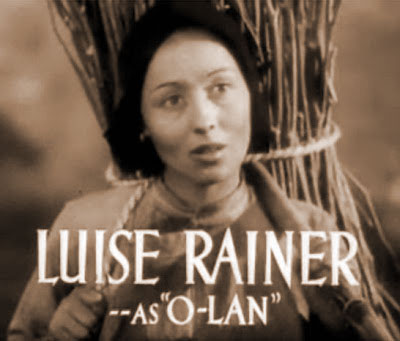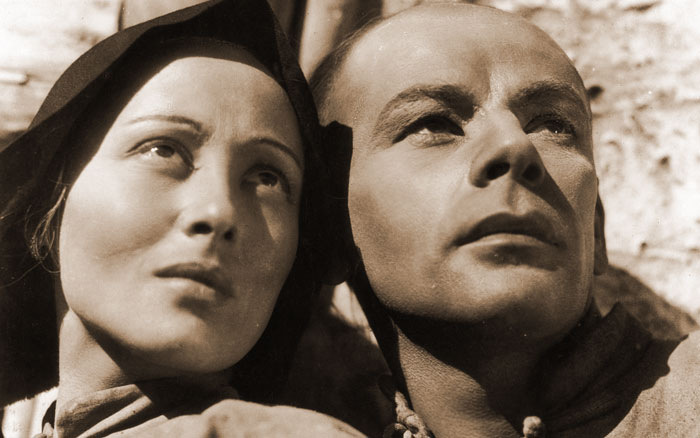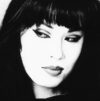Film criticism
The Good Earth film review
What happened when Anna May Wong tried to win the biggest role of her career, playing the leading Chinese character O-lan in MGM’s 1937 blockbuster movie of Pearl S Buck’s Pulitzer Prize winning novel, The Good Earth, set in China?
The Good Earth: Anna May Wong and Chinese in Hollywood
Film critique by Anna Chen, 30 December 2008

Every so often I get together with friends for a day of culture. This generally entails snuggling up in my flat over a movie, a bottle (or more) of cava and munchies. Chocolate will invariably make an appearance, as sometimes does proper Jewish cheesecake from the bagel bakery, far superior to the ersatz frozen slabs of synthetic goo which should only be eaten as emergency therapy after the tragic break-up of a love affair, and straight from the freezer.
Last night we dug in for a night of cinematic frolix. Several bottles of cava may have been involved. Still, what better way to settle down to all 143 minutes of a Hollywood classic, the “last great achievement” of renowned film producer, Irving Thalberg, before he passed on to the Great Cinema in the sky?
I finally got to see The Good Earth, of which I’d been vaguely aware all my life but which surfaced again during my research into my BBC Radio 4 profile of the Hollywood screen-legend, Anna May Wong (to be broadcast 13th January 2009). This was the black and white MGM spectacular made in 1937, based on the Pulitzer Prize-winning bestseller by Pearl S Buck about the turbulent fortunes of farmer Wang Lung’s family — a sort of Chinese Grapes of Wrath meets Gone With The Wind.
You’d think the biggest ever film role for a Chinese should be played by the biggest ever Chinese star. Ever since publication of the book in 1931, Anna May Wong had lobbied hard for the starring role of O-Lan, Wang Lung’s long-suffering wife. Fed up with being cast as either dragon ladies or prostitutes, this character meant a proper starring role at last for Anna and entry to the A-list.
But vicious race laws meant that you couldn’t have mixed race romance on the screen. Once a white actor, Paul Muni, was cast in the lead his wife would have to be played by a white actress in yellowface.

And what better choice for a strugglng Chinese peasant than the German actress, Luise Rainer? Luise did achieve an other-worldlyness and won an Oscar for her portrayal of O-Lan which has been described as “luminous” and “magical”. But, as film historian Kevin Brownlow says in the programme [A Celestial Star in Piccadilly], “she wasn’t Chinese”.
Acting styles have changed over the years but key roles were played with a distinct absence of gorm. Poor Luise had hardly any lines but a lot of screen-time to fill. Mostly she filled it with an open mouthed passivity reminiscent of Elizabeth Berkley in Showgirls. The dialogue she did speak was delivered with a thick Germanic accent but who cares? It was foreign, wasn’t it?
Would Anna May Wong have made a better O-Lan than Rainer? Ever since Garbo stared into the cosmic distance on the prow of her ship in Queen Christina and achieved demi-god status, actresses have been trying for the same effect with differing results. No inner life but a beautiful, blank canvas onto which the audience projects the best of itself. It’s a seductive image. Who wouldn’t want to look like they have a hotline straight to god? Even I’ve tried it but failed to keep the requisite immobile face, not being particularly inscrutable, see? Rainer does this to perfection. For 143 straight minutes.
So this is how good Chinese women were portrayed during the heyday of Hollywood, when its movies described the world, laying out its cultural templates, and woe betide anyone who strayed from the Grand Design. I must have been asleep when they gave those lessons coz look at me now.
Anna May Wong was beautiful and authentically Chinese but she had far too much going on inside. Unless she blanded herself utterly, her natural charisma and thought-processes would have upset the symmetry and harmony of white folk’s art.
That‘s not to say the film isn’t worth seeing. If you can suspend disbelief at the racial origins of the actors, you can marvel at the sheer gorgeousness of Hollywood cinematography at its height. Something else Kevin Brownlow told me but we didn’t have time to include in the final cut: how did the director achieve the amazing effect of vast clouds of locusts swarming across the Chinese landscape at the climax of the film? They turned the film upside down and placed a tank of water in front of it. Then, as the film was running, they poured coffee grounds into the tank so they swirled in dark clouds. Then they turned the film the right way and it looks as if tonnes of locust biomass is rising above puny humanity. Fantastic!
The Good Earth. Gorgeous looking but another set of invisible chains I can do without, thank you very much.
The Good Earth — directed by Sidney Franklin, Victor Fleming (uncredited) and Gustav Machaty.
Anna Chen writes and presents Anna May Wong: A Celestial Star in Piccadilly, broadcast 11:30am Tuesday 13th January 2009. Listen again online for seven days after transmission plus repeats.
SEE ALSO:
ANNA MAY WONG: A Celestial Star in Piccadilly, BBC Radio 4 (2009). Anna Chen wrote and presented the profile of Hollywood’s first screen legend, Anna May Wong, introducing new audiences to the most famous Chinese woman of the 1920s and 30s in the West. Broadcast on BBC Radio 4 in January 2009.
YELLOWFACE: Dehumanisation starts by being rendered invisible and turned into a blank canvas onto which constructed images are projected, supplying a permanent reservoir of scapegoats. A raft of exclusions despite Britain’s record of colonisation embed yellow peril stereotypes deep into the collective unconscious. Examples can be found at this page.
Not Your China Doll: The Wild and Shimmering Life of Anna May Wong by Katie Gee Salisbury. A lively, well-written journey through Anna May Wong’s life and career, if light on the political landscape that shaped her. Book review by Anna Chen, 11 April 2024 – READ MORE >>>
